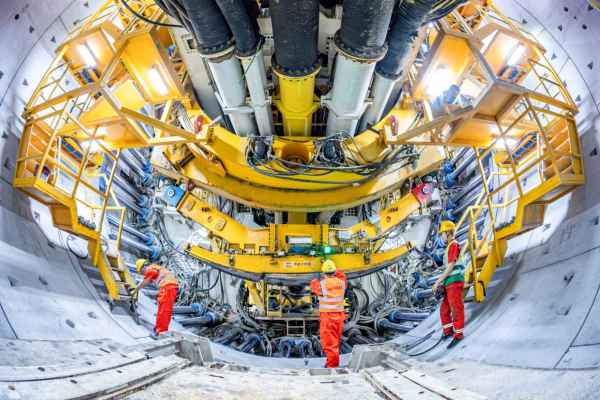On May 19, the super-large diameter tunnel boring machine (TBM) named “Jincheng No.1” successfully bore through beneath the Haihe River in Tianjin.

A view of the super-large diameter tunnel boring machine “Jincheng No.1” [Photo/sasac.gov.cn]
The tunnel, constructed by the China Railway 14th Bureau Group Corporation Limited under China Railway Construction Corporation Limited, is part of the Tianjin-Weifang High-Speed Railway project and has achieved over 5,000 meters of total tunneling progress.
The Tianjin-Weifang High-Speed Railway starts at Binhai Station in Tianjin and connects to Weifang North Station on the Jinan-Qingdao High-Speed Railway. The main line stretches 348.9 kilometers with 10 stations and is designed for speeds of up to 350 km/h. The Jin-Gu Haihe Tunnel, about 6.7 kilometers long, is the only tunnel along the railway and features the largest shield diameter ever constructed beneath the Haihe River.
Tunneling is being carried out using the domestically produced “Jincheng No.1” slurry balance TBM, which has a maximum excavation diameter of 13.8 meters.
During the river crossing, the TBM tunneled beneath a 267-meter-wide section of the river, with a minimal cover of just 17.3 meters below the riverbed and a maximum water depth of 12 meters.
Complex geological conditions, including fractured zones, soft soils and layers prone to liquefaction, posed significant technical challenges. The construction team navigated these conditions while minimizing environmental disruption and maintaining structural integrity near existing infrastructures such as the Central Avenue Haihe Tunnel.
To ensure the safe passage of the TBM under the Haihe River, the construction team adopted innovative techniques such as shield muck treatment technology and a dual-liquid synchronous grouting system.
As a key link in China’s high-speed rail network, the line forms part of both the Beijing-Shanghai and Coastal Corridors. Upon completion, it will significantly enhance connectivity within the Bohai Economic Rim, support the coordinated development of the Beijing-Tianjin-Hebei region, and contribute to the growth of the Shandong Peninsula urban cluster.
(Executive editor: Yuan Ting)